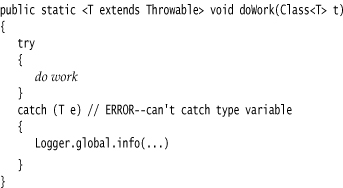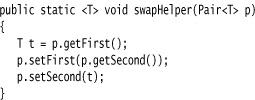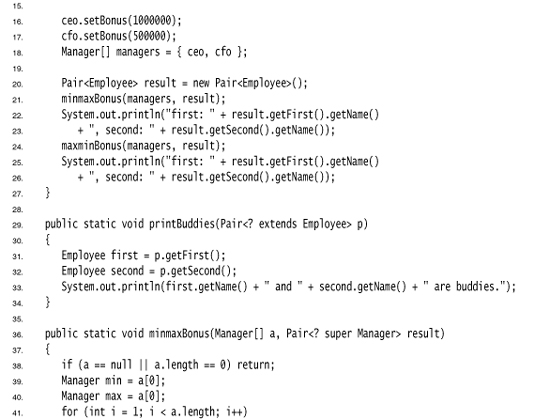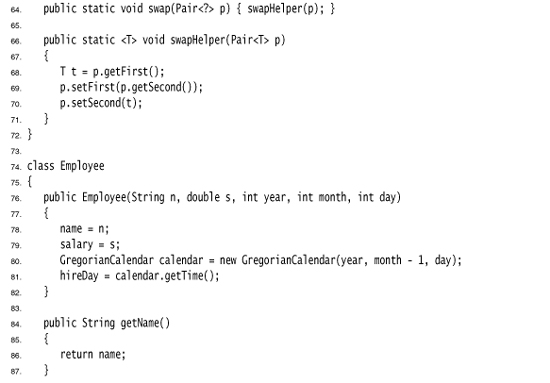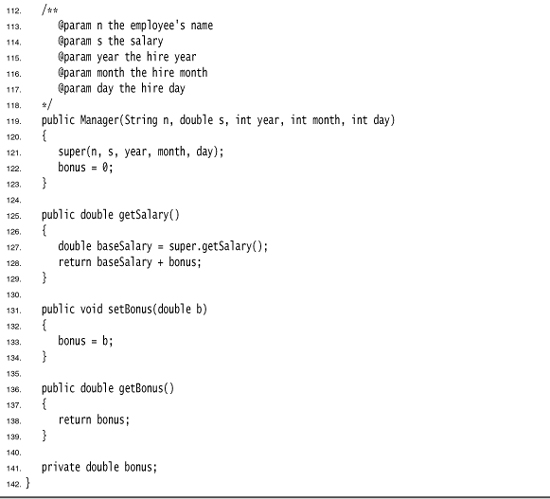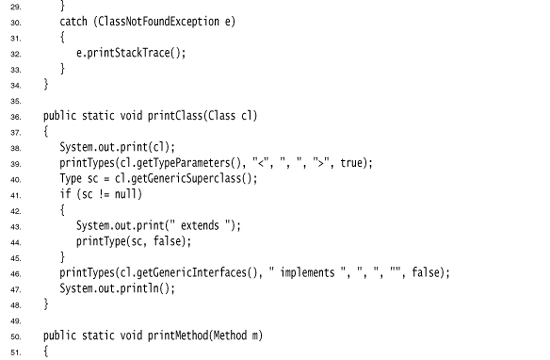Chapter 12. Generic Programming
• DEFINITION OF A SIMPLE GENERIC CLASS
• GENERIC CODE AND THE VIRTUAL MACHINE
• RESTRICTIONS AND LIMITATIONS
• INHERITANCE RULES FOR GENERIC TYPES
Generics constitute the most significant change in the Java programming language since the 1.0 release. The addition of generics to Java SE 5.0 was the result of one of the first Java Specification Requests, JSR 14, that was formulated in 1999. The expert group spent about five years on specifications and test implementations.
Generics are desirable because they let you write code that is safer and easier to read than code that is littered with Object variables and casts. Generics are particularly useful for collection classes, such as the ubiquitous ArrayList.
Generics are—at least on the surface—similar to templates in C++. In C++, as in Java, templates were first added to the language to support strongly typed collections. However, over the years, other uses were discovered. After reading this chapter, perhaps you will find novel uses for Java generics in your programs.
Why Generic Programming?
Generic programming means to write code that can be reused for objects of many different types. For example, you don’t want to program separate classes to collect String and File objects. And you don’t have to—the single class ArrayList collects objects of any class. This is one example of generic programming.
Before Java SE 5.0, generic programming in Java was always achieved with inheritance. The ArrayList class simply maintained an array of Object references:
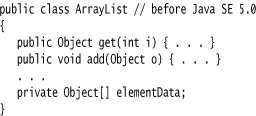
This approach has two problems. A cast is necessary whenever you retrieve a value:
ArrayList files = new ArrayList();
. . .
String filename = (String) files.get(0);
Moreover, there is no error checking. You can add values of any class:
files.add(new File(". . ."));
This call compiles and runs without error. Elsewhere, casting the result of get to a String will cause an error.
Generics offer a better solution: type parameters. The ArrayList class now has a type parameter that indicates the element type:
ArrayList<String> files = new ArrayList<String>();
This makes your code easier to read. You can tell right away that this particular array list contains String objects.
The compiler can make good use of this information too. No cast is required for calling get. The compiler knows that the return type is String, not Object:
String filename = files.get(0);
The compiler also knows that the add method of an ArrayList<String> has a parameter of type String. That is a lot safer than having an Object parameter. Now the compiler can check that you don’t insert objects of the wrong type. For example, the statement
files.add(new File(". . .")); // can only add String objects to an ArrayList<String>
will not compile. A compiler error is much better than a class cast exception at runtime.
This is the appeal of type parameters: they make your programs easier to read and safer.
Who Wants to Be a Generic Programmer?
It is easy to use a generic class such as ArrayList. Most Java programmers will simply use types such as ArrayList<String> as if they had been built into the language, just like String[] arrays. (Of course, array lists are better than arrays because they can expand automatically.)
However, it is not so easy to implement a generic class. The programmers who use your code will want to plug in all sorts of classes for your type parameters. They expect everything to work without onerous restrictions and confusing error messages. Your job as a generic programmer, therefore, is to anticipate all the potential future uses of your class.
How hard can this get? Here is a typical issue that the designers of the standard class library had to grapple with. The ArrayList class has a method addAll to add all elements of another collection. A programmer may want to add all elements from an ArrayList<Manager> to an ArrayList<Employee>. But, of course, doing it the other way around should not be legal. How do you allow one call and disallow the other? The Java language designers invented an ingenious new concept, the wildcard type, to solve this problem. Wildcard types are rather abstract, but they allow a library builder to make methods as flexible as possible.
Generic programming falls into three skill levels. At a basic level, you just use generic classes—typically, collections such as ArrayList—without thinking how and why they work. Most application programmers will want to stay at that level until something goes wrong. You may encounter a confusing error message when mixing different generic classes, or when interfacing with legacy code that knows nothing about type parameters. At that point, you need to learn enough about Java generics to solve problems systematically rather than through random tinkering. Finally, of course, you may want to implement your own generic classes and methods.
Application programmers probably won’t write lots of generic code. The folks at Sun have already done the heavy lifting and supplied type parameters for all the collection classes. As a rule of thumb, only code that traditionally involved lots of casts from very general types (such as Object or the Comparable interface) will benefit from using type parameters.
In this chapter, we tell you everything you need to know to implement your own generic code. However, we expect most readers to use this knowledge primarily for help with troubleshooting, and to satisfy their curiosity about the inner workings of the parameterized collection classes.
Definition of a Simple Generic Class
A generic class is a class with one or more type variables. In this chapter, we use a simple Pair class as an example. This class allows us to focus on generics without being distracted by data storage details. Here is the code for the generic Pair class:
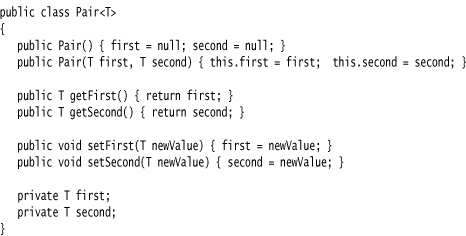
The Pair class introduces a type variable T, enclosed in angle brackets < >, after the class name. A generic class can have more than one type variable. For example, we could have defined the Pair class with separate types for the first and second field:
public class Pair<T, U> { . . . }
The type variables are used throughout the class definition to specify method return types and the types of fields and local variables. For example:
private T first; // uses type variable
It is common practice to use uppercase letters for type variables, and to keep them short. The Java library uses the variable E for the element type of a collection, K and V for key and value types of a table, and T (and the neighboring letters U and S, if necessary) for “any type at all”.
You instantiate the generic type by substituting types for the type variables, such as
Pair<String>
You can think of the result as an ordinary class with constructors
Pair<String>()
Pair<String>(String, String)
and methods
String getFirst()
String getSecond()
void setFirst(String)
void setSecond(String)
In other words, the generic class acts as a factory for ordinary classes.
The program in Listing 12–1 puts the Pair class to work. The static minmax method traverses an array and simultaneously computes the minimum and maximum value. It uses a Pair object to return both results. Recall that the compareTo method compares two strings, returning 0 if the strings are identical, a negative integer if the first string comes before the second in dictionary order, and a positive integer otherwise.
Superficially, generic classes in Java are similar to template classes in C++. The only obvious difference is that Java has no special template keyword. However, as you will see throughout this chapter, there are substantial differences between these two mechanisms.
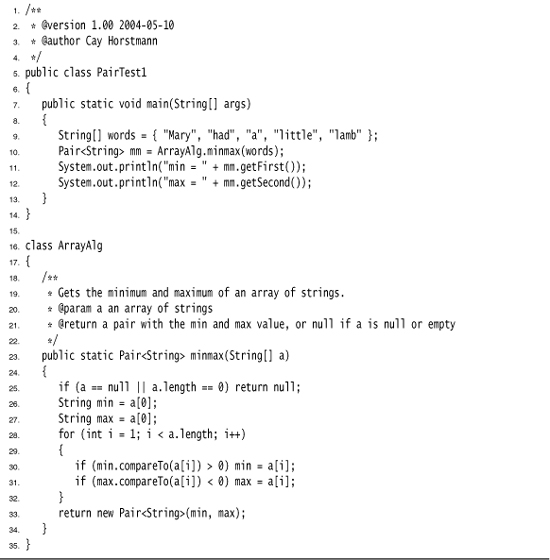
Generic Methods
In the preceding section, you have seen how to define a generic class. You can also define a single method with type parameters.
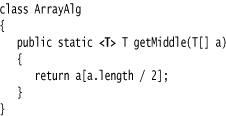
This method is defined inside an ordinary class, not inside a generic class. However, it is a generic method, as you can see from the angle brackets and the type variable. Note that the type variables are inserted after the modifiers (public static, in our case) and before the return type.
You can define generic methods both inside ordinary classes and inside generic classes.
When you call a generic method, you can place the actual types, enclosed in angle brackets, before the method name:
String[] names = { "John", "Q.", "Public" };
String middle = ArrayAlg.<String>getMiddle(names);
In this case (and indeed in most cases), you can omit the <String> type parameter from the method call. The compiler has enough information to infer the method that you want. It matches the type of names (that is, String[]) against the generic type T[] and deduces that T must be String. That is, you can simply call
String middle = ArrayAlg.getMiddle(names);
In almost all cases, type inference for generic methods works smoothly. Occasionally, the compiler gets it wrong, and you’ll need to decipher an error report. Consider this example:
double middle = ArrayAlg.getMiddle(3.14, 1729, 0);
The error message is: “found: java.lang.Number&java.lang.Comparable<? extends java.lang.Number&java.lang.Comparable<?>>, required: double”. You will learn later in this chapter how to decipher the “found” type declaration. In a nutshell, the compiler autoboxed the parameters into a Double and two Integer objects, and then it tried to find a common supertype of these classes. It actually found two: Number and the Comparable interface, which is itself a generic type. In this case, the remedy is to write all parameters as double values.
Peter von der Ahé recommends this trick if you want to see which type the compiler infers for a generic method call: Purposefully introduce an error and study the resulting error message. For example, consider the call ArrayAlg.getMiddle("Hello", 0, null). Assign the result to a JButton, which can’t possibly be right. You will get an error report “found:
java.lang.Object&java.io.Serializable&java.lang.Comparable<? extendsjava.lang.Object&java.io.Serializable&java.lang.Comparable<?>>."
In plain English, you can assign the result to Object, Serializable, or Comparable.
In C++, you place the type parameters after the method name. That can lead to nasty parsing ambiguities. For example, g(f<a,b>(c)) can mean “call g with the result of f<a,b>(c)”, or “call g with the two boolean values f<a and b>(c)”.
Bounds for Type Variables
Sometimes, a class or a method needs to place restrictions on type variables. Here is a typical example. We want to compute the smallest element of an array:

But there is a problem. Look inside the code of the min method. The variable smallest has type T, which means that it could be an object of an arbitrary class. How do we know that the class to which T belongs has a compareTo method?
The solution is to restrict T to a class that implements the Comparable interface—a standard interface with a single method, compareTo. You achieve this by giving a bound for the type variable T:
public static <T extends Comparable> T min(T[] a) . . .
Actually, the Comparable interface is itself a generic type. For now, we will ignore that complexity and the warnings that the compiler generates. “Wildcard Types” on page 632 discusses how to properly use type parameters with the Comparable interface.
Now, the generic min method can only be called with arrays of classes that implement the Comparable interface, such as String, Date, and so on. Calling min with a Rectangle array is a compile-time error because the Rectangle class does not implement Comparable.
In C++, you cannot restrict the types of template parameters. If a programmer instantiates a template with an inappropriate type, an (often obscure) error message is reported inside the template code.
You may wonder why you use the extends keyword rather than the implements keyword in this situation—after all, Comparable is an interface. The notation
<T extends BoundingType>
expresses that T should be a subtype of the bounding type. Both T and the bounding type can be either a class or an interface. The extends keyword was chosen because it is a reasonable approximation of the subtype concept, and the Java designers did not want to add a new keyword (such as sub) to the language.
A type variable or wildcard can have multiple bounds. For example:
T extends Comparable & Serializable
The bounding types are separated by ampersands (&) because commas are used to separate type variables.
As with Java inheritance, you can have as many interface supertypes as you like, but at most one of the bounds can be a class. If you have a class as a bound, it must be the first one in the bounds list.
In the next sample program (Listing 12–2), we rewrite the minmax method to be generic. The method computes the minimum and maximum of a generic array, returning a Pair<T>.
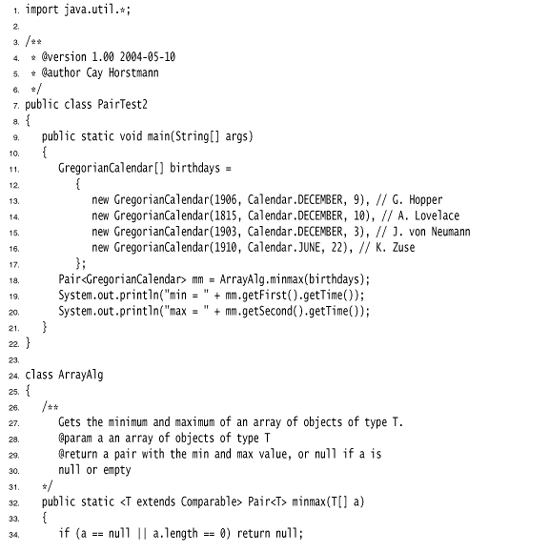
Generic Code and the Virtual Machine
The virtual machine does not have objects of generic types—all objects belong to ordinary classes. An earlier version of the generics implementation was even able to compile a program that uses generics into class files that executed on 1.0 virtual machines! This backward compatibility was only abandoned fairly late in the development for Java generics. If you use the Sun compiler to compile code that uses Java generics, the resulting class files will not execute on pre-5.0 virtual machines.
If you want to have the benefits of generics while retaining bytecode compatibility with older virtual machines, check out http://sourceforge.net/projects/retroweaver. The Retroweaver program rewrites class files so that they are compatible with older virtual machines.
Whenever you define a generic type, a corresponding raw type is automatically provided. The name of the raw type is simply the name of the generic type, with the type parameters removed. The type variables are erased and replaced by their bounding types (or Object for variables without bounds.)
For example, the raw type for Pair<T> looks like this:
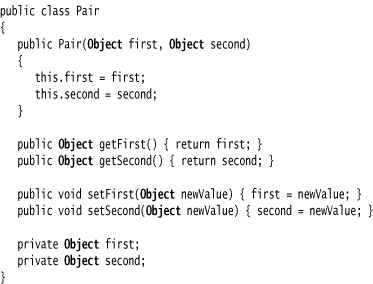
Because T is an unbounded type variable, it is simply replaced by Object.
The result is an ordinary class, just as you might have implemented it before generics were added to the Java programming language.
Your programs may contain different kinds of Pair, such as Pair<String> or Pair<GregorianCalendar>, but erasure turns them all into raw Pair types.
In this regard, Java generics are very different from C++ templates. C++ produces different types for each template instantiation, a phenomenon called “template code bloat.” Java does not suffer from this problem.
The raw type replaces type variables with the first bound, or Object if no bounds are given. For example, the type variable in the class Pair<T> has no explicit bounds, hence the raw type replaces T with Object. Suppose we declare a slightly different type:
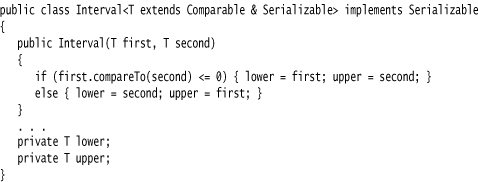
The raw type Interval looks like this:

You may wonder what happens if you switch the bounds: class Interval<Serializable & Comparable>. In that case, the raw type replaces T with Serializable, and the compiler inserts casts to Comparable when necessary. For efficiency, you should therefore put tagging interfaces (that is, interfaces without methods) at the end of the bounds list.
Translating Generic Expressions
When you program a call to a generic method, the compiler inserts casts when the return type has been erased. For example, consider the sequence of statements
Pair<Employee> buddies = . . .;
Employee buddy = buddies.getFirst();
The erasure of getFirst has return type Object. The compiler automatically inserts the cast to Employee. That is, the compiler translates the method call into two virtual machine instructions:
• A call to the raw method Pair.getFirst
• A cast of the returned Object to the Employee type
Casts are also inserted when you access a generic field. Suppose the first and second fields of the Pair class were public. (Not a good programming style, perhaps, but it is legal Java.) Then the expression
Employee buddy = buddies.first;
also has a cast inserted in the resulting byte codes.
Translating Generic Methods
Type erasure also happens for generic methods. Programmers usually think of a generic method such as
public static <T extends Comparable> T min(T[] a)
as a whole family of methods, but after erasure, only a single method is left:
public static Comparable min(Comparable[] a)
Note that the type parameter T has been erased, leaving only its bounding type Comparable.
Erasure of method brings up a couple of complexities. Consider this example:
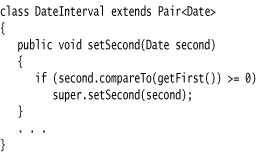
A date interval is a pair of Date objects, and we’ll want to override the methods to ensure that the second value is never smaller than the first. This class is erased to

Perhaps surprisingly, there is another setSecond method, inherited from Pair, namely,
public void setSecond(Object second)
This is clearly a different method because it has a parameter of a different type—Object instead of Date. But it shouldn’t be different. Consider this sequence of statements:
DateInterval interval = new DateInterval(. . .);
Pair<Date> pair = interval; // OK--assignment to superclass
pair.setSecond(aDate);
Our expectation is that the call to setSecond is polymorphic and that the appropriate method is called. Because pair refers to a DateInterval object, that should be DateInterval.setSecond. The problem is that the type erasure interferes with polymorphism. To fix this problem, the compiler generates a bridge method in the DateInterval class:
public void setSecond(Object second) { setSecond((Date) second); }
To see why this works, let us carefully follow the execution of the statement
pair.setSecond(aDate)
The variable pair has declared type Pair<Date>, and that type only has a single method called setSecond, namely setSecond(Object). The virtual machine calls that method on the object to which pair refers. That object is of type DateInterval. Therefore, the method DateInterval.setSecond(Object) is called. That method is the synthesized bridge method. It calls DateInterval.setSecond(Date), which is what we want.
Bridge methods can get even stranger. Suppose the DateInterval method also overrides the getSecond method:

In the erased type, there are two getSecond methods:
Date getSecond() // defined in DateInterval
Object getSecond() // defined in Pair
You could not write Java code like that—it would be illegal to have two methods with the same parameter types—here, no parameters. However, in the virtual machine, the parameter types and the return type specify a method. Therefore, the compiler can produce bytecodes for two methods that differ only in their return type, and the virtual machine will handle this situation correctly.
Bridge methods are not limited to generic types. We already noted in Chapter 5 that, starting with Java SE 5.0, it is legal for a method to specify a more restrictive return type when overriding another method. For example:

The Object.clone and Employee.clone methods are said to have covariant return types.
Actually, the Employee class has two clone methods:
Employee clone() // defined aboveObject clone() // synthesized bridge method, overrides Object.clone
The synthesized bridge method calls the newly defined method.
In summary, you need to remember these facts about translation of Java generics:
• There are no generics in the virtual machines, only ordinary classes and methods.
• All type parameters are replaced by their bounds.
• Bridge methods are synthesized to preserve polymorphism.
• Casts are inserted as necessary to preserve type safety.
Calling Legacy Code
Lots of Java code was written before Java SE 5.0. If generic classes could not interoperate with that code, they would probably not be widely used. Fortunately, it is straightforward to use generic classes together with their raw equivalents in legacy APIs.
Let us look at a concrete example. To set the labels of a JSlider, you use the method
void setLabelTable(Dictionary table)
In Chapter 9, we used the following code to populate the label table:
Dictionary<Integer, Component> labelTable = new Hashtable<Integer, Component>();
labelTable.put(0, new JLabel(new ImageIcon("nine.jpg")));
labelTable.put(20, new JLabel(new ImageIcon("ten.jpg")));
. . .
slider.setLabelTable(labelTable); // WARNING
In Java SE 5.0, the Dictionary and Hashtable classes were turned into a generic class. Therefore, we are able to form Dictionary<Integer, Component> instead of using a raw Dictionary. However, when you pass the Dictionary<Integer, Component> object to setLabelTable, the compiler issues a warning.
Dictionary<Integer, Component> labelTable = . . .;
slider.setLabelTable(labelTable); // WARNING
After all, the compiler has no assurance about what the setLabelTable might do to the Dictionary object. That method might replace all the keys with strings. That breaks the guarantee that the keys have type Integer, and future operations may cause bad cast exceptions.
There isn’t much you can do with this warning, except ponder it and ask what the JSlider is likely going to do with this Dictionary object. In our case, it is pretty clear that the JSlider only reads the information, so we can ignore the warning.
Now consider the opposite case, in which you get an object of a raw type from a legacy class. You can assign it to a parameterized type variable, but of course you will get a warning. For example:
Dictionary<Integer, Components> labelTable = slider.getLabelTable(); // WARNING
That’s ok—review the warning and make sure that the label table really contains Integer and Component objects. Of course, there never is an absolute guarantee. A malicious coder might have installed a different Dictionary in the slider. But again, the situation is no worse than it was before Java SE 5.0. In the worst case, your program will throw an exception.
After you are done pondering the warning, you can use an annotation to make it disappear. The annotation must be placed before the method whose code generates the warning, like this:
@SuppressWarnings("unchecked")
public void configureSlider() { . . . }
Unfortunately, this annotation turns off checking for all code inside the method. It is a good idea to isolate potentially unsafe code into separate methods so that they can be reviewed more easily.
The Hashtable class is a concrete subclass of the abstract Dictionary class. Both Dictionary and Hashtable have been declared as “obsolete” ever since they were superseded by the Map interface and the HashMap class of Java SE 1.2. Apparently though, they are still alive and kicking. After all, the JSlider class was only added in Java SE 1.3. Didn’t its programmers know about the Map class by then? Does this make you hopeful that they are going to adopt generics in the near future? Well, that’s the way it goes with legacy code.
Restrictions and Limitations
In the following sections, we discuss a number of restrictions that you need to consider when working with Java generics. Most of these restrictions are a consequence of type erasure.
Type Parameters Cannot Be Instantiated with Primitive Types
You cannot substitute a primitive type for a type parameter. Thus, there is no Pair<double>, only Pair<Double>. The reason is, of course, type erasure. After erasure, the Pair class has fields of type Object, and you can’t use them to store double values.
This is an annoyance, to be sure, but it is consistent with the separate status of primitive types in the Java language. It is not a fatal flaw—there are only eight primitive types, and you can always handle them with separate classes and methods when wrapper types are not an acceptable substitute.
Runtime Type Inquiry Only Works with Raw Types
Objects in the virtual machine always have a specific nongeneric type. Therefore, all type inquiries yield only the raw type. For example,
if (a instanceof Pair<String>) // same as a instanceof Pair
really only tests whether a is a Pair of any type. The same is true for the test
if (a instanceof Pair<T>) // T is ignored
or the cast
Pair<String> p = (Pair<String>) a; // WARNING--can only test that a is a Pair
To remind you of the risk, you will get a compiler warning whenever you use instanceof or cast expressions that involve generic types.
In the same spirit, the getClass method always returns the raw type. For example:
Pair<String> stringPair = . . .;
Pair<Employee> employeePair = . . .;
if (stringPair.getClass() == employeePair.getClass()) // they are equal
The comparison yields true because both calls to getClass return Pair.class.
You Cannot Throw or Catch Instances of a Generic Class
You can neither throw nor catch objects of a generic class. In fact, it is not even legal for a generic class to extend Throwable. For example, the following definition will not compile:
public class Problem<T> extends Exception { /* . . . */ } // ERROR--can't extend Throwable
You cannot use a type variable in a catch clause. For example, the following method will not compile:
However, it is ok to use type variables in exception specifications. The following method is legal:
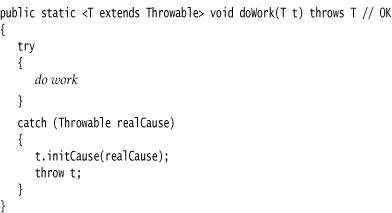
Arrays of Parameterized Types Are Not Legal
You cannot declare arrays of parameterized types, such as
Pair<String>[] table = new Pair<String>[10]; // ERROR
What’s wrong with that? After erasure, the type of table is Pair[]. You can convert it to Object[]:
Object[] objarray = table;
An array remembers its component type and throws an ArrayStoreException if you try to store an element of the wrong type:
objarray[0] = "Hello"; // ERROR--component type is Pair
But erasure renders this mechanism ineffective for generic types. The assignment
objarray[0] = new Pair<Employee>();
would pass the array store check but still result in a type error. For this reason, arrays of parameterized types are outlawed.
If you need to collect parameterized type objects, simply use an ArrayList:ArrayList<Pair<String>> is safe and effective.
You Cannot Instantiate Type Variables
You cannot use type variables in expression such as new T(...), new T[...], or T.class. For example, the following Pair<T> constructor is illegal:
public Pair() { first = new T(); second = new T(); } // ERROR
Type erasure would change T to Object, and surely you don’t want to call new Object().
As a workaround, you can construct generic objects through reflection, by calling the Class.newInstance method.
Unfortunately, the details are a bit complex. You cannot call
first = T.class.newInstance(); // ERROR
The expression T.class is not legal. Instead, you must design the API so that you are handed a Class object, like this:

This method could be called as follows:
Pair<String> p = Pair.makePair(String.class);
Note that the Class class is itself generic. For example, String.class is an instance (indeed, the sole instance) of Class<String>. Therefore, the makePair method can infer the type of the pair that it is making.
You cannot construct a generic array:
public static <T extends Comparable> T[] minmax(T[] a) { T[] mm = new T[2]; . . . } // ERROR
Type erasure would cause this method to always construct an array Object[2].
If the array is only used as a private instance field of a class, you can declare the array as Object[] and use casts when retrieving elements. For example, the ArrayList class could be implemented as follows:

The actual implementation is not quite as clean:

Here, the cast E[] is an outright lie, but type erasure makes it undetectable.
This technique does not work for our minmax method since we are returning a T[] array, and a runtime error results if we lie about its type. Suppose we implement

The call
String[] ss = minmax("Tom", "Dick", "Harry");
compiles without any warning. A ClassCastException occurs when the Object[] reference is assigned to the String[] variable.
In this situation, you can use reflection and call Array.newInstance:

The toArray method of the ArrayList class is not so lucky. It needs to produce a T[] array, but it doesn’t have the component type. Therefore, there are two variants:
Object[] toArray()
T[] toArray(T[] result)
The second method receives an array parameter. If the array is large enough, it is used. Otherwise, a new array of sufficient size is created, using the component type of result.
Type Variables Are Not Valid in Static Contexts of Generic Classes
You cannot reference type variables in static fields or methods. For example, the following clever idea won’t work:
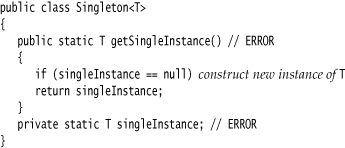
If this could be done, then a program could declare a Singleton<Random> to share a random number generator and a Singleton<JFileChooser> to share a file chooser dialog. But it can’t work. After type erasure there is only one Singleton class, and only one singleInstance field. For that reason, static fields and methods with type variables are simply outlawed.
Beware of Clashes After Erasure
It is illegal to create conditions that cause clashes when generic types are erased. Here is an example. Suppose we add an equals method to the Pair class, like this:
Consider a Pair<String>. Conceptually, it has two equals methods:
boolean equals(String) // defined in Pair<T>
boolean equals(Object) // inherited from Object
But the intuition leads us astray. The erasure of the method
boolean equals(T)
is
boolean equals(Object)
which clashes with the Object.equals method.
The remedy is, of course, to rename the offending method.
The generics specification cites another rule: “To support translation by erasure, we impose the restriction that a class or type variable may not at the same time be a subtype of two interface types which are different parameterizations of the same interface.” For example, the following is illegal:
![]()
GregorianCalendar would then implement both Comparable<Calendar> and Comparable<GregorianCalendar>, which are different parameterizations of the same interface.
It is not obvious what this restriction has to do with type erasure. After all, the nongeneric version
class Calendar implements Comparable { . . . }
class GregorianCalendar extends Calendar implements Comparable { . . . }
is legal. The reason is far more subtle. There would be a conflict with the synthesized bridge methods. A class that implements Comparable<X> gets a bridge method
public int compareTo(Object other) { return compareTo((X) other); }
You cannot have two such methods for different types X.
Inheritance Rules for Generic Types
When you work with generic classes, you need to learn a few rules about inheritance and subtypes. Let’s start with a situation that many programmers find unintuitive. Consider a class and a subclass, such as Employee and Manager. Is Pair<Manager> a subclass of Pair<Employee>? Perhaps surprisingly, the answer is “no.” For example, the following code will not compile:
Manager[] topHonchos = . . .;
Pair<Employee> result = ArrayAlg.minmax(topHonchos); // ERROR
The minmax method returns a Pair<Manager>, not a Pair<Employee>, and it is illegal to assign one to the other.
In general, there is no relationship between Pair<S> and Pair<T>, no matter how S and T are related (see Figure 12–1).
Figure 12–1. No inheritance relationship between pair classes
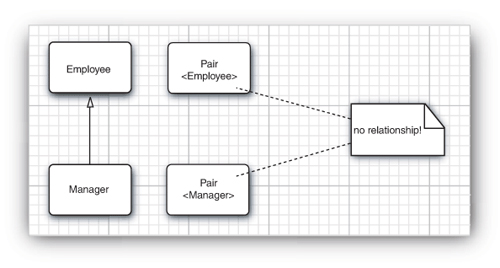
This seems like a cruel restriction, but it is necessary for type safety. Suppose we were allowed to convert a Pair<Manager> to a Pair<Employee>. Consider this code:
Pair<Manager> managerBuddies = new Pair<Manager>(ceo, cfo);
Pair<Employee> employeeBuddies = managerBuddies; // illegal, but suppose it wasn't
employeeBuddies.setFirst(lowlyEmployee);
Clearly, the last statement is legal. But employeeBuddies and managerBuddies refer to the same object. We now managed to pair up the CFO with a lowly employee, which should not be possible for a Pair<Manager>.
You just saw an important difference between generic types and Java arrays. You can assign a Manager[] array to a variable of type Employee[]:
Manager[] managerBuddies = { ceo, cfo };Employee[] employeeBuddies = managerBuddies; // OK
However, arrays come with special protection. If you try to store a lowly employee into employeeBuddies[0], the virtual machine throws an ArrayStoreException.
You can always convert a parameterized type to a raw type. For example, Pair<Employee> is a subtype of the raw type Pair. This conversion is necessary for interfacing with legacy code.
Can you convert to the raw type and then cause a type error? Unfortunately, you can. Consider this example:
Pair<Manager> managerBuddies = new Pair<Manager>(ceo, cfo);
Pair rawBuddies = managerBuddies; // OK
rawBuddies.setFirst(new File(". . .")); // only a compile-time warning
This sounds scary. However, keep in mind that you are no worse off than you were with older versions of Java. The security of the virtual machine is not at stake. When the foreign object is retrieved with getFirst and assigned to a Manager variable, a ClassCastException is thrown, just as in the good old days. You merely lose the added safety that generic programming normally provides.
Finally, generic classes can extend or implement other generic classes. In this regard, they are no different from ordinary classes. For example, the class ArrayList<T> implements the interface List<T>. That means, an ArrayList<Manager> can be converted to a List<Manager>. However, as you just saw, an ArrayList<Manager> is not an ArrayList<Employee> or List<Employee>. Figure 12–2 shows these relationships.
Figure 12–2. Subtype relationships among generic list types
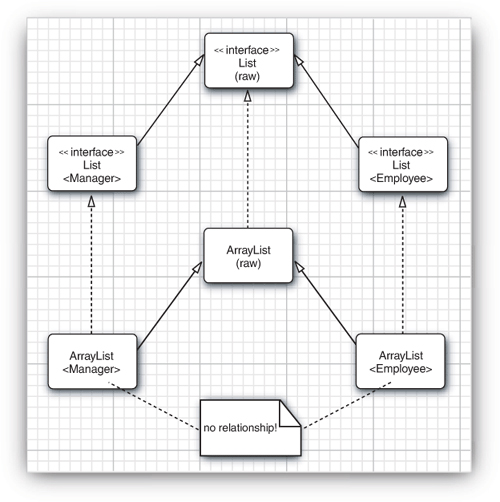
Wildcard Types
It was known for some time among researchers of type systems that a rigid system of generic types is quite unpleasant to use. The Java designers invented an ingenious (but nevertheless safe) “escape hatch”: the wildcard type. For example, the wildcard type
Pair<? extends Employee>
denotes any generic Pair type whose type parameter is a subclass of Employee, such as Pair<Manager>, but not Pair<String>.
Let’s say you want to write a method that prints out pairs of employees, like this:

As you saw in the preceding section, you cannot pass a Pair<Manager> to that method, which is rather limiting. But the solution is simple—use a wildcard type:
public static void printBuddies(Pair<? extends Employee> p)
The type Pair<Manager> is a subtype of Pair<? extends Employee> (see Figure 12–3).
Figure 12–3. Subtype relationships with wildcards
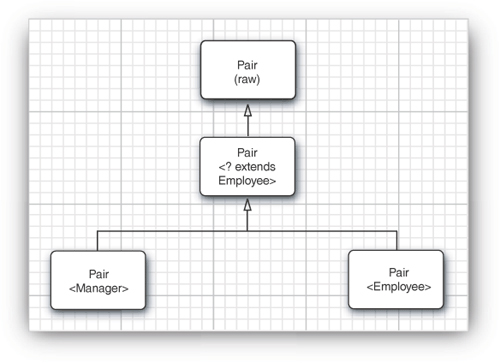
Can we use wildcards to corrupt a Pair<Manager> through a Pair<? extends Employee> reference?
Pair<Manager> managerBuddies = new Pair<Manager>(ceo, cfo);
Pair<? extends Employee> wildcardBuddies = managerBuddies; // OK
wildcardBuddies.setFirst(lowlyEmployee); // compile-time error
No corruption is possible. The call to setFirst is a type error. To see why, let us have a closer look at the type Pair<? extends Employee>. Its methods look like this:
? extends Employee getFirst()
void setFirst(? extends Employee)
This makes it impossible to call the setFirst method. The compiler only knows that it needs some subtype of Employee, but it doesn’t know which type. It refuses to pass any specific type—after all, ? might not match it.
We don’t have this problem with getFirst: It is perfectly legal to assign the return value of getFirst to an Employee reference.
This is the key idea behind bounded wildcards. We now have a way of distinguishing between the safe accessor methods and the unsafe mutator methods.
Supertype Bounds for Wildcards
Wildcard bounds are similar to type variable bounds, but they have an added capability—you can specify a supertype bound, like this:
? super Manager
This wildcard is restricted to all supertypes of Manager. (It was a stroke of good luck that the existing super keyword describes the relationship so accurately.)
Why would you want to do this? A wildcard with a supertype bound gives you the opposite behavior of the wildcards described in the section “Wildcard Types” on page 632. You can supply parameters to methods, but you can’t use the return values. For example, Pair<? super Manager> has methods
void setFirst(? super Manager)
? super Manager getFirst()
The compiler doesn’t know the exact type of the setFirst method but can call it with any object of type Manager, Employee, or Object, but not a subtype such as Executive. However, if you call getFirst, there is no guarantee about the type of the returned object. You can only assign it to an Object.
Here is a typical example. We have an array of managers and want to put the manager with the lowest and highest bonus into a Pair object. What kind of Pair? A Pair<Employee> should be fair game or, for that matter, a Pair<Object> (see Figure 12–4). The following method will accept any appropriate Pair:
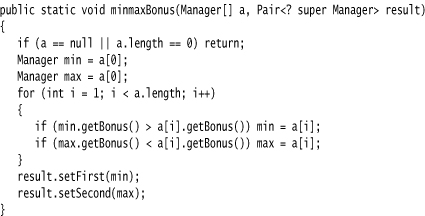
Figure 12–4. A wildcard with a supertype bound
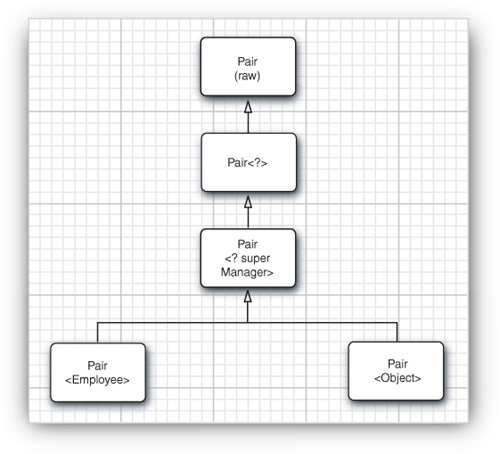
Intuitively speaking, wildcards with supertype bounds let you write to a generic object, wildcards with subtype bounds let you read from a generic objects.
Here is another use for supertype bounds. The Comparable interface is itself a generic type. It is declared as follows:
Here, the type variable indicates the type of the other parameter. For example, the String class implements Comparable<String>, and its compareTo method is declared as
public int compareTo(String other)
This is nice—the explicit parameter has the correct type. Before Java SE 5.0, other was an Object, and a cast was necessary in the implementation of the method.
Because Comparable is a generic type, perhaps we should have done a better job with the min method of the ArrayAlg class? We could have declared it as
public static <T extends Comparable<T>> T min(T[] a)
This looks more thorough than just using T extends Comparable, and it would work fine for many classes. For example, if you compute the minimum of a String array, then T is the type String, and String is a subtype of Comparable<String>. But we run into a problem when processing an array of GregorianCalendar objects. As it happens, GregorianCalendar is a subclass of Calendar, and Calendar implements Comparable<Calendar>. Thus, GregorianCalendar implements Comparable<Calendar> but not Comparable<GregorianCalendar>.
In a situation such as this one, supertypes come to the rescue:
public static <T extends Comparable<? super T>> T min(T[] a) . . .
Now the compareTo method has the form
int compareTo(? super T)
Maybe it is declared to take an object of type T, or—for example, when T is GregorianCalendar—a supertype of T. At any rate, it is safe to pass an object of type T to the compareTo method.
To the uninitiated, a declaration such as <T extends Comparable<? super T>> is bound to look intimidating. This is unfortunate, because the intent of this declaration is to help application programmers by removing unnecessary restrictions on the call parameters. Application programmers with no interest in generics will probably learn quickly to gloss over these declarations and just take for granted that library programmers will do the right thing. If you are a library programmer, you’ll need to get used to wildcards, or your users will curse you and throw random casts at their code until it compiles.
Unbounded Wildcards
You can even use wildcards with no bounds at all, for example, Pair<?>. At first glance, this looks identical to the raw Pair type. Actually, the types are very different. The type Pair<?> has methods such as
? getFirst()
void setFirst(?)
The return value of getFirst can only be assigned to an Object. The setFirst method can never be called, not even with an Object. That’s the essential difference between Pair<?> and Pair: you can call the setFirst method of the raw Pair class with any Object.
Why would you ever want such a wimpy type? It is useful for very simple operations. For example, the following method tests whether a pair contains a null reference. It never needs the actual type.

You could have avoided the wildcard type by turning contains into a generic method:
public static <T> boolean hasNulls(Pair<T> p)
However, the version with the wildcard type seems easier to read.
Wildcard Capture
Let us write a method that swaps the elements of a pair:
public static void swap(Pair<?> p)
A wildcard is not a type variable, so we can’t write code that uses ? as a type. In other words, the following would be illegal:
? t = p.getFirst(); // ERROR
p.setFirst(p.getSecond());
p.setSecond(t);
That’s a problem because we need to temporarily hold the first element when we do the swapping. Fortunately, there is an interesting solution to this problem. We can write a helper method, swapHelper, like this:
Note that swapHelper is a generic method, whereas swap is not—it has a fixed parameter of type Pair<?>.
Now we can call swapHelper from swap:
public static void swap(Pair<?> p) { swapHelper(p); }
In this case, the parameter T of the swapHelper method captures the wildcard. It isn’t known what type the wildcard denotes, but it is a definite type, and the definition of <T>swapHelper makes perfect sense when T denotes that type.
Of course, in this case, we were not compelled to use a wildcard. We could have directly implemented <T> void swap(Pair<T> p) as a generic method without wildcards. However, consider this example in which a wildcard type occurs naturally in the middle of a computation:

Here, the wildcard capture mechanism cannot be avoided.
Wildcard capture is only legal in very limited circumstances. The compiler must be able to guarantee that the wildcard represents a single, definite type. For example, the T in ArrayList<Pair<T>> can never capture the wildcard in ArrayList<Pair<?>>. The array list might hold two Pair<?>, each of which has a different type for ?.
The test program in Listing 12–3 gathers up the various methods that we discussed in the preceding sections, so that you can see them in context.

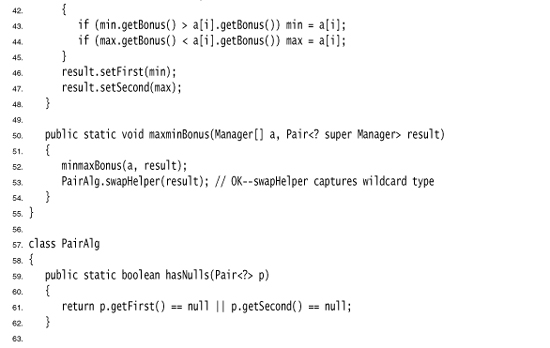

Reflection and Generics
The Class class is now generic. For example, String.class is actually an object (in fact, the sole object) of the class Class<String>.
The type parameter is useful because it allows the methods of Class<T> to be more specific about their return types. The following methods of Class<T> take advantage of the type parameter:
T newInstance()
T cast(Object obj)
T[] getEnumConstants()
Class<? super T> getSuperclass()
Constructor<T> getConstructor(Class... parameterTypes)
Constructor<T> getDeclaredConstructor(Class... parameterTypes)
The newInstance method returns an instance of the class, obtained from the default constructor. Its return type can now be declared to be T, the same type as the class that is being described by Class<T>. That saves a cast.
The cast method returns the given object, now declared as type T if its type is indeed a subtype of T. Otherwise, it throws a BadCastException.
The getEnumConstants method returns null if this class is not an enum class or an array of the enumeration values, which are known to be of type T.
Finally, the getConstructor and getDeclaredConstructor methods return a Constructor<T> object. The Constructor class has also been made generic so that its newInstance method has the correct return type.
![]()
• T newInstance() 5.0
• T cast(Object obj) 5.0
• T[] getEnumConstants() 5.0
• Class<? super T> getSuperclass() 5.0
• Constructor<T> getConstructor(Class... parameterTypes) 5.0
• Constructor<T> getDeclaredConstructor(Class... parameterTypes) 5.0
java.lang.reflect.Constructor<T> 1.1
![]()
• T newInstance(Object... parameters) 5.0
Using Class<T> Parameters for Type Matching
It is sometimes useful to match the type variable of a Class<T> parameter in a generic method. Here is the canonical example:

If you call
makePair(Employee.class)
then Employee.class is an object of type Class<Employee>. The type parameter T of the makePair method matches Employee, and the compiler can infer that the method returns a Pair<Employee>.
Generic Type Information in the Virtual Machine
One of the notable features of Java generics is the erasure of generic types in the virtual machine. Perhaps surprisingly, the erased classes still retain some faint memory of their generic origin. For example, the raw Pair class knows that it originated from the generic class Pair<T>, even though an object of type Pair can’t tell whether it was constructed as a Pair<String> or Pair<Employee>.
Similarly, consider a method
public static Comparable min(Comparable[] a)
that is the erasure of a generic method
public static <T extends Comparable<? super T>> T min(T[] a)
You can use the reflection API enhancements of Java SE 5.0 to determine that
• The generic method has a type parameter called T;
• The type parameter has a subtype bound that is itself a generic type;
• The bounding type has a wildcard parameter;
• The wildcard parameter has a supertype bound; and
• The generic method has a generic array parameter.
In other words, you get to reconstruct everything about generic classes and methods that their implementors declared. However, you won’t know how the type parameters were resolved for specific objects or method calls.
The type information that is contained in class files to enable reflection of generics is incompatible with older virtual machines.
In order to express generic type declarations, Java SE 5.0 introduced a new interface Type in the java.lang.reflect package. The interface has the following subtypes:
• The Class class, describing concrete types
• The TypeVariable interface, describing type variables (such as T extends Comparable<? super T>)
• The WildcardType interface, describing wildcards (such as ? super T)
• The ParameterizedType interface, describing generic class or interface types (such as Comparable<? super T>)
• The GenericArrayType interface, describing generic arrays (such as T[])
Figure 12–5 shows the inheritance hierarchy. Note that the last four subtypes are interfaces—the virtual machine instantiates suitable classes that implement these interfaces.
Figure 12–5. The Type class and its descendants
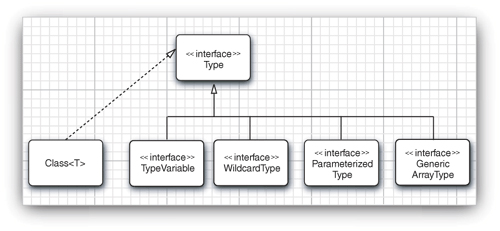
Listing 12–4 uses the generic reflection API to print out what it discovers about a given class. If you run it with the Pair class, you get this report:
class Pair<T> extends java.lang.Object
public T getFirst()
public T getSecond()
public void setFirst(T)
public void setSecond(T)
If you run it with ArrayAlg in the PairTest2 directory, the report displays the following method:
public static <T extends java.lang.Comparable> Pair<T> minmax(T[])
The API notes at the end of this section describe the methods used in the example program.
Listing 12–4. GenericReflectionTest.java
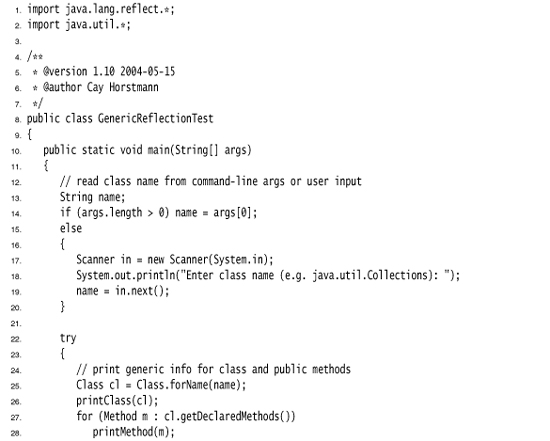

![]()
• TypeVariable[] getTypeParameters() 5.0
• Type getGenericSuperclass() 5.0
• Type[] getGenericInterfaces() 5.0
![]()
• TypeVariable[] getTypeParameters() 5.0
• Type getGenericReturnType() 5.0
• Type[] getGenericParameterTypes() 5.0
java.lang.reflect.TypeVariable 5.0
![]()
• String getName()
• Type[] getBounds()
java.lang.reflect.WildcardType 5.0
![]()
• Type[] getLowerBounds()
• Type[] getUpperBounds()
java.lang.reflect.ParameterizedType 5.0
![]()
• Type getRawType()
• Type[] getActualTypeArguments()
• Type getOwnerType()
java.lang.reflect.GenericArrayType 5.0
![]()
• Type getGenericComponentType()
You now know how to use generic classes and how to program your own generic classes and methods if the need arises. Just as importantly, you know how to decipher the generic type declarations that you may encounter in the API documentation and in error messages. For an exhaustive discussion of everything there is to know about Java generics, turn to Angelika Langer’s excellent list of frequently (and not so frequently) asked questions at http://angelikalanger.com/GenericsFAQ/JavaGenericsFAQ.html.
In the next chapter, you will see how the Java collections framework puts generics to work.


